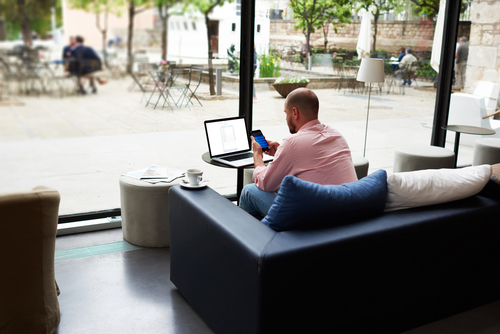In July I dedicated my blog to write about a massive ransomware attach affecting individuals and businesses worldwide and offered solutions protect against them (see https://rbsmn.com/blog/page/4/ for complete post). However, most people that were not exposed to that attack are vulnerable to a hack coming through a different door; using public WiFi at your local coffee house or airport. In this post I’ll provide 6 ways you can protect yourself or business from being hacked using public WiFi. While most of these vetted protections could be implemented by yourself, recently many of my customers (both individuals and businesses) have come to RB’s Computer Service requesting help to implement them. We welcome this, and generally speaking we can button up your WiFi security in a couple hours. For more involved business networks, RB’s Computer Service offers monthly Managed IT Service Agreements (really, for the price one pays for lunch each day of the month).
- #1 Turn Off File Sharing and Air Drops
You may not know if a hacker is on the public network you’re using, but you can control what is seen from your computer. Regardless if you’re using a Windows PC or a Mac, your computer probably has file sharing options that assume you’re on a trusted network with other trusted networks or computers. Turn off file sharing in Windows and macOS, enable your system’s built-in firewalls, and keep internet-connected apps and services to a minimum. Mac users, take the extra step and set AirDrop to contacts-only. Next, automate those settings so your machine is open when you’re at home or on a trusted network, and then automatically switches to a more secure setup when you’re not. (Lifehacker Staff, Lifehacker.com, Top 10 Ways to Stay Safe On Public Wi-Fi Networks, February 4th, 2017, https://lifehacker.com/top-10-ways-to-stay-safe-on-public-wi-fi-networks-1791800347)
- #2 Turn off WiFi when not in use.
This one is pretty easy to do. If you don’t need something connected to a network, don’t connect it. When you’re finished working online, turn Wi-Fi off on your laptop, tablet, or smartphone. (Lifehacker Staff, Lifehacker.com, Top 10 Ways to Stay Safe On Public Wi-Fi Networks, February 4th, 2017, https://lifehacker.com/top-10-ways-to-stay-safe-on-public-wi-fi-networks-1791800347)
- #3 Keep Antivirus and Antimalware up to date.
When you use a public network, ensure your computer is running some kind of antimalware utility and complementary antivirus utility. (Lifehacker Staff, Lifehacker.com, Top 10 Ways to Stay Safe On Public Wi-Fi Networks, February 4th, 2017, https://lifehacker.com/top-10-ways-to-stay-safe-on-public-wi-fi-networks-1791800347)
- #4 Install Privacy-Protection Browser Extensions
Antimalware is essential, but it only really protects you from things you download and execute, blocking malvertising or malware winding up on your system. The next step is to fortify your browser with tools designed to protect your privacy. This is important because network attacks like session hijacking and clickjacking—both of which are still real threats, and can give people access to things like your Amazon account or Facebook account, even if you’re browsing securely. (Lifehacker Staff, Lifehacker.com, Top 10 Ways to Stay Safe On Public Wi-Fi Networks, February 4th, 2017, https://lifehacker.com/top-10-ways-to-stay-safe-on-public-wi-fi-networks-1791800347)
- #5 Use a VPN
VPNs (Virtual Private Networks) reroute your traffic through dedicated, encrypted servers. Either pay up for a reputable VPN service or go for a well-known and established free one. Most now offer apps for desktop and mobile use, so they’re easy to install and use. (David Nield, Field Guide, How to Stay Safe on Public Wi-Fi, June 16th, 2016, https://fieldguide.gizmodo.com/how-to-stay-safe-on-public-wifi-1779464400)
- #6 Use your own WiFi
The BEST protection is not using a public WiFi at all. You can do this by bringing your own with you. Whether you use a mobile hotspot like a MiFi or a Karma, or you just tether to your smartphone and use your wireless carrier’s data, both approaches get you off of the sketchy public Wi-Fi at the airport while you’re waiting for your layover and onto cellular data instead. These “hotspot” devices are small and easy to carry around. Plus, most offer affordable subscription options. (Lifehacker Staff, Lifehacker.com, Top 10 Ways to Stay Safe On Public Wi-Fi Networks, February 4th, 2017, https://lifehacker.com/top-10-ways-to-stay-safe-on-public-wi-fi-networks-1791800347) There are several other things you can consider to protect yourself when using a public WiFi. These 6 are essential in my opinion. While on the surface they appear easily to implement on your own, several of our customers have asked us to help them configure and implement them. Generally speaking, RB’s Computer Service can button up your WiFi security in a couple of hours. For more involved business networks, RB’s Computer Service offers monthly Managed IT Service Agreements (really, for the price one pays for lunch each day of the month). Please contact me via phone or email: 763-441-3884, techs@rbsmn.com to discuss your needs. In addition public WiFi security solutions, we sell the best desktop and laptop computers, the best commercial grade firewall routers, business computers, computer parts, computer monitors and provide computer repair, iPhone and smartphone repair and tablet repairs to customers and clients throughout Central Minnesota.

